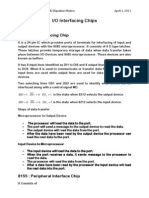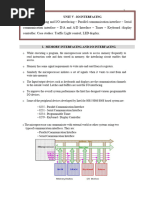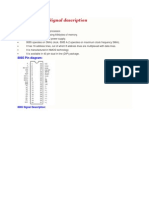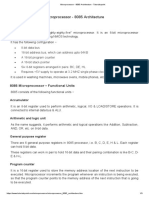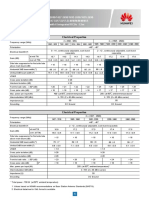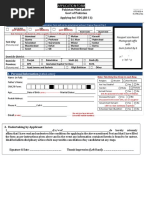Unit Ii Hardware Interfacing With Intel 8085
Unit Ii Hardware Interfacing With Intel 8085
Uploaded by
Basheer V.PCopyright:
Available Formats
Unit Ii Hardware Interfacing With Intel 8085
Unit Ii Hardware Interfacing With Intel 8085
Uploaded by
Basheer V.POriginal Description:
Original Title
Copyright
Available Formats
Share this document
Did you find this document useful?
Is this content inappropriate?
Copyright:
Available Formats
Unit Ii Hardware Interfacing With Intel 8085
Unit Ii Hardware Interfacing With Intel 8085
Uploaded by
Basheer V.PCopyright:
Available Formats
Department of ECE Unit 2-RGCET
UNIT II
HARDWARE INTERFACING WITH INTEL 8085
I/O INTERFACING WITH 8085
There are two types for interfacing I/O devices:
1. Memory mapped I/O device.
2. Standard I/O mapped I/O device or isolated I/O mapping.
Example 1:
A system requires 16kb EPROM and 16kb RAM. Also the system has 2 numbers of
8255, one number of 8279, one number of 8251 and one number of 8254. (8255 -
Programmable peripheral interface; 8279-Keyboard/display controller, 8251 - USART
and 8254 - Timer). Draw the Interface diagram. Allocate addresses to all the devices. The
peripheral IC should be I/O mapped.
The I/O devices in the system should be mapped by standard I/O mapping. Hence
separate decoders can be used to generate chip select signals for memory IC
and peripheral IC's.
For 16kb EPROM, we can provide 2 numbers of 2764(8k x 8) EPROM.
For 16kb RAM we can provide 2 numbers of 6264 (8k x 8) RAM.
The 8kb memories require 13 address lines. Hence the address lines A0 - A12 are
used for selecting the memory locations.
The unused address lines A13, A14 and A15 are used as input to decoder
74LS138 (3-to-8-deeoder) of memory IC. The logic low enables of this decoder
are tied to IO/ M(low) of 8085, so that this decoder is enabled for memory
read/write operation. The other enable pins of decoder are tied to appropriate
logic levels permanently. The 4-outputs of the decoder are used to select memory
lCs and the remaining 4 are kept for future expansion.
The EPROM is mapped in the beginning of memory space from 0000H to 3FFF.
The RAM is mapped at the end of memory space from C000 to FFFFH.
Microprocessors and Microcontrollers 1
Department of ECE Unit 2-RGCET
There are five peripheral IC's to be interfaced to the system. The chip-select
signals for these IC's are given through another 3-to-8 decoder 74LS138 (I/O
decoder). The input to this decoder is A11, A12 and A13
The address lines A13, A14 and A15 are logically ORed and applied to low
enable of I/O decoder.
The logic high enable of I/O decoder is tied to IO / M(low) signal of 8085, so that
this decoder is enabled for I/O read/write operation.
Fig - Internal address of 8255
Microprocessors and Microcontrollers 2
Department of ECE Unit 2-RGCET
Fig - Memory and I/O Port Interfacing with 8085
I/O STRUCTURE OF A TYPICAL MICROCOMPUTER:
There are three major types of data transfer between the microcomputer and art I/O
device. They are,
Programmed I/O : In programmed I/O the data transfer is accomplished through
an I/O port and controlled by software.
Interrupt driven I/O : In interrupt driven I/O, the I/O device will interrupt the
processor, and initiate data transfer.
Direct memory access (DMA) : In DMA, the data transfer between memory and
I/O can be performed by bypassing the microprocessor.
Microprocessors and Microcontrollers 3
Department of ECE Unit 2-RGCET
INTERFACING I/O AND PERIPHERAL DEVICES:
1. For data transfer from input device to processor the following operations are
performed.
The input device will load the data to the port.
When the port receives a data, it sends message to the processor to read the data.
The processor will read the data from the port.
After a data have been read by the processor the input device will load the next
data into the port.
2. For data transfer from processor to output device the following operations are
performed.
The processor will load the data to the port.
The port will send a message to the output device to read the data.
The output device will read the data from the port.
After the data have been read by the output device the processor can load the next
data to the port.
The various INTEL 110 port devices are 8212, 8155/8156, 8255, 8355 and 8755.
8212
The 8212 is a 24 pin IC.
It consists of eight number of D-type latches.
It has 8-input lines DI1 to DI8 and 8-output lines DO1 to DO8
The 8212 can be used as an input or output device
It has two selecting device DS1 (low) and DS2.
Microprocessors and Microcontrollers 4
Department of ECE Unit 2-RGCET
Fig - Internal address of 8155
8155:
It has two numbers of 8-bit parallel I/O port (port-A and B)
One number of 6-bit parallel I/O port (port-C).
It has 14 bit timer (operating in 4 modes).
It has six internal addresses.
It has one chip select pin CS (low).
8156:
It has two numbers of 8-bit parallel I/O port (port-A and B)
One number of 6-bit parallel 1 port (port-C).
It has 14 bit timer (operating in 4 modes).
It has six internal addresses.
It has one chip select pin CS (low).
Microprocessors and Microcontrollers 5
Department of ECE Unit 2-RGCET
Fig - Internal address of 8156
8255:
It has 3 numbers of 8-bit parallel I/O ports (port A, B and C).
Port-A can be programmed in mode-0 mode-1 or mode-2 as input or output port.
Port-B can be programmed in mode-1 and mode-2 as 1/Oport.
When ports A and B are in mode-0, the port-C can be used as I/O port.
One logic low chip select (CS) pin.
It requires four internal addresses
8355:
It has 2KB ROM.
It has two number of 8 bit port (A,B).
It has one CS(low).
It has four internal addresses.
8755:
It has 2Kb EPROM.
It has two number of 8 bit port (A,B).
It has one CS(low).
It has four internal addresses.
Microprocessors and Microcontrollers 6
Department of ECE Unit 2-RGCET
Fig - Internal address of 8255
Fig - Internal address of 8355
Fig - Internal address of 8755
Microprocessors and Microcontrollers 7
Department of ECE Unit 2-RGCET
MEMORY INTERFACING WITH 8085
The memory is made up of semiconductor material used to store the programs and data.
Three types of memory is,
Process memory
Primary or main memory
Secondary memory
Microprocessors and Microcontrollers 8
Department of ECE Unit 2-RGCET
TYPICAL EPROM AND STATIC RAM:
A typical semiconductor memory IC will have n address pins, m data pins (or
output pins).
Having two power supply pins (one for connecting required supply voltage (V
and the other for connecting ground).
The control signals needed for static RAM are chip select (chip enable), read
control (output enable) and write control (write enable).
The control signals needed for read operation in EPROM are chip select (chip
enable) and read control (output enable).
DECODER:
It is used to select the memory chip of processor during the execution of a program. No
of IC's used for decoder is,
2-4 decoder (74LS139)
3-8 decoder (74LS138)
Microprocessors and Microcontrollers 9
Department of ECE Unit 2-RGCET
Table - Number of Address Pins and Data Pins in Memory ICs
Fig - Block diagram and Truth table of 2-4 decoder
Microprocessors and Microcontrollers 10
Department of ECE Unit 2-RGCET
Fig - Block diagram and Truth table of 3-8 decoder
PROGRAMMABLE INTERRUPT CONTROLLER - INTEL 8259
FEATURES OF 8259:
1. It is programmed to work with either 8085 or 8086 processor.
2. It manage 8-interrupts according to the instructions written into its control registers.
3. In 8086 processor, it supplies the type number of the interrupt and the type number is
programmable. In 8085 processor, the interrupt vector address is programmable. The
priorities of the interrupts are programmable.
4. The interrupts can be masked or unmasked individually.
5. The 8259s can be cascaded to accept a maximum of 64 interrupts.
Microprocessors and Microcontrollers 11
Department of ECE Unit 2-RGCET
FUNCTIONAL BLOCK DIAGRAM OF 8259:
It has eight functional blocks. They are,
1. Control logic
2. Read Write logic
3. Data bus buffer
4. Interrupt Request Register (IRR)
5. In-Service Register (ISR)
6. Interrupt Mask Register (IMR)
7. Priority Resolver (PR)
8. Cascade buffer.
The data bus and its buffer are used for the following activities.
1. The processor sends control word to data bus buffer through D0-D7.
2. The processor read status word from data bus buffer through D0-D7
3. From the data bus buffer the 8259 send type number (in case of 8086) or the call
opcode and address (in case of 8085) through D0-D7 to the processor.
The processor uses the RD (low), WR (low) and A0 to read or write 8259.
The 8259 is selected by CS (low).
The IRR has eight input lines (IR0-IR7) for interrupts. When these lines go high,
the request is stored in IRR. It registers a request only if the interrupt is
unmasked.
Normally IR0 has highest priority and IR7 has the lowest priority. The priorities
of the interrupt request input are also programmable.
Microprocessors and Microcontrollers 12
Department of ECE Unit 2-RGCET
First the 8259 should be programmed by sending Initialization Command Word
(ICW) and Operational Command Word (OCW). These command words will
inform 8259 about the following,
Type of interrupt signal (Level triggered / Edge triggered).
1. Type of processor (8085/8086).
2. Call address and its interval (4 or 8)
3. Masking of interrupts.
4. Priority of interrupts.
5. Type of end of interrupts.
The interrupt mask register (IMR) stores the masking bits of the interrupt lines to
be masked. The relevant information is send by the processor through OCW.
The in-service register keeps track of which interrupt is currently being serviced.
The priority resolver examines the interrupt request, mask and in-service registers
and determines whether INT signal should be sent to the processor or not.
The cascade buffer/comparator is used to expand the interrupts of 8259.
In cascade connection one 8259 will be directly interrupting 8086 and it is called
master 8259.
To each interrupt request input of master 8259 (IR0-IR7), one slave 8259 can be
connected. The 8259s interrupting the master 8259 are called slave 8259s.
Each 8259 has its own addresses so that each 8259 can be programmed
independently by sending command words and independently the status bytes can
be read from it.
Microprocessors and Microcontrollers 13
Department of ECE Unit 2-RGCET
PERIPHERAL INTERFACING - PPI INTERFACING (8255)
Peripheral Interfacing is considered to be a main part of Microprocessor, as it is the only
way to interact with the external world. The interfacing happens with the ports of the
Microprocessor.
The main IC's which are to be interfaced with 8085 are:
1. 8255 PPI
2. 8259 PIC
3. 8251 USART
4. 8279 Key board display controller
5. 8253 Timer/ Counter
6. A/D and D/A converter interfacing.
PROGRAMMABLE PERIPHERAL INTERFACE - INTEL 8255
Pins, Signals and internal block diagram of 8255:
It has 40 pins and requires a single +5V supply.
The INTEL 8255 is a device used to parallel data transfer between processor and
slow peripheral devices like ADC, DAC, keyboard, 7-segment display, LCD, etc.
The 8255 has three ports: Port-A, Port-B and Port-C.
Port-A can be programmed to work in any one of the three operating modes
mode-0, mode-1 and mode-2 as input or output port.
Port-B can be programmed to work either in mode-0 or mode-1 as input or output
port.
Port-C (8-pins) has different assignments depending on the mode of port-A and
port-B.
If port-A and B are programmed in mode-0, then the port-C can perform any one
of the following functions.
Microprocessors and Microcontrollers 14
Department of ECE Unit 2-RGCET
As 8-bit parallel port in mode-0 for input or output.
As two numbers of 4-bit parallel ports in mode-0 for input or output.
The individual pins of port-C can be set or reset for various control applications.
If port-A is programmed in mode- 1/mode-2 and port-B is programmed in mode-1
then some of the pins of port-C are used for handshake signals and the remaining
pins can be used as input/ output lines or individually set/reset for control
applications.
The read/write control logic requires six control signals. These signals are given
below.
1. RD (low): This control signal enables the read operation. When this signal is low, the
microprocessor reads data from a selected I/O port of the 8255A.
2. WR (low): This control signal enables the write operation. When this signal goes low,
the microprocessor writes into a selected I/O port or the control register.
3. RESET: This is an active high signal. It clears the control register and set all ports in
the input mode.
4. CS (low), A0 and A1: These are device select signals. They are,
Interfacing of 8255 with 8085 processor:
A simple schematic for interfacing the 8255 with 8085 processor is shown in fig.
Microprocessors and Microcontrollers 15
Department of ECE Unit 2-RGCET
Block diagram of 8255:
The internal block diagram of 8255 is shown in fig:
Microprocessors and Microcontrollers 16
Department of ECE Unit 2-RGCET
The 8255 can be either memory mapped or I/O mapped in the system. In the
schematic shown in above is I/O mapped in the system.
Using a 3-to-8 decoder generates the chip select signals for I/O mapped devices.
The address lines A4, A5 and A6 are decoded to generate eight chip select signals
(IOCS-0 to IOCS-7) and in this, the chip select IOCS- 1 is used to select 8255.
The address line A7 and the control signal IO/M (low) are used as enable for the
decoder.
The address line A0 of 8085 is connected to A0 of 8255 and A1 of 8085 is
connected to A1 of 8255 to provide the internal addresses.
The data lines D0-D7 are connected to D0-D7 of the processor to achieve parallel
data transfer.
The I/O addresses allotted to the internal devices of 8255 are listed in table.
Microprocessors and Microcontrollers 17
Department of ECE Unit 2-RGCET
INTERFACING WITH INTEL 8251A (USART)
The 8251A is a programmable serial communication interface chip designed for
synchronous and asynchronous serial data communication.
It supports the serial transmission of data.
It is packed in a 28 pin DIP.
It is packed in a 28 pin DIP.
Microprocessors and Microcontrollers 18
Department of ECE Unit 2-RGCET
Read/Write control logic:
The Read/Write Control logic interfaces the 8251A with CPU, determines the
functions of the 8251A according to the control word written into its control
register.
It monitors the data flow.
This section has three registers and they are control register, status register and
data buffer.
Microprocessors and Microcontrollers 19
Department of ECE Unit 2-RGCET
The active low signals RD, WR, CS and C/D(Low) are used for read/write
operations with these three registers.
When C/D(low) is high, the control register is selected for writing control word or
reading status word.
When C/D(low) is low, the data buffer is selected for read/write operation.
When the reset is high, it forces 8251A into the idle mode.
The clock input is necessary for 8251A for communication with CPU and this
clock does not control either the serial transmission or the reception rate.
Transmitter section:
The transmitter section accepts parallel data from CPU and converts them into
serial data.
The transmitter section is double buffered, i.e., it has a buffer register to hold an
8-bit parallel data and another register called output register to convert the parallel
data into serial bits.
When output register is empty, the data is transferred from buffer to output
register. Now the processor can again load another data in buffer register.
If buffer register is empty, then TxRDY is goes to high.
If output register is empty then TxEMPTY goes to high.
The clock signal, TxC (low) controls the rate at which the bits are transmitted by
the USART.
The clock frequency can be 1,16 or 64 times the baud rate.
Microprocessors and Microcontrollers 20
Department of ECE Unit 2-RGCET
Receiver Section:
The receiver section accepts serial data and convert them into parallel data
The receiver section is double buffered, i.e., it has an input register to receive
serial data and convert to parallel, and a buffer register to hold the parallel data.
When the RxD line goes low, the control logic assumes it as a START bit, waits
for half a bit time and samples the line again.
If the line is still low, then the input register accepts the following bits, forms a
character and loads it into the buffer register.
The CPU reads the parallel data from the buffer register.
When the input register loads a parallel data to buffer register, the RxRDY line
goes high.
The clock signal RxC (low) controls the rate at which bits are received by the
USART.
During asynchronous mode, the signal SYNDET/BRKDET will indicate the
break in the data transmission.
During synchronous mode, the signal SYNDET/BRKDET will indicate the
reception of synchronous character.
MODEM Control:
The MODEM control unit allows to interface a MODEM to 8251A and to
establish data communication through MODEM over telephone lines.
This unit takes care of handshake signals for MODEM interface.
The 825 1A can be either memory mapped or I/O mapped in the system.
Microprocessors and Microcontrollers 21
Department of ECE Unit 2-RGCET
8251A in I/O mapped in the system is shown in the figure.
Using a 3-to-8 decoder generates the chip select signals for I/O mapped devices.
The address lines A4, A5 and A6 are decoded to generate eight chip select signals
(IOCS-0 to IOCS-7) and in this, the chip select signal IOCS-2 is used to select
8251A.
The address line A7 and the control signal IO / M(low) are used as enable for
decoder.
The address line A0 of 8085 is connected to C/D(low) of 8251A to provide the
internal addresses.
The data lines D0 - D7 are connected to D0 - D7 of the processor to achieve
parallel data transfer.
The RESET and clock signals are supplied by the processor. Here the processor
clock is directly connected to 8251A. This clock controls the parallel data transfer
between the processor and 8251A.
The output clock signal of 8085 is divided by suitable clock dividers like
programmable timer 8254 and then used as clock for serial transmission and
reception.
The TTL logic levels of the serial data lines and the control signals necessary for
serial transmission and reception are converted to RS232 logic levels using
MAX232 and then terminated on a standard 9-pin D-.type connector.
In 8251A the transmission and reception baud rates can be different or same.
The device which requires serial communication with processor can be connected
to this 9-pin D-type connector using 9-core cable
Microprocessors and Microcontrollers 22
Department of ECE Unit 2-RGCET
The signals TxEMPTY, TxRDY and RxRDY can be used as interrupt signals to
initiate interrupt driven data transfer scheme between processor and 8251 A.
I/O addresses of 8251A interfaced to 8085 is,
Microprocessors and Microcontrollers 23
Department of ECE Unit 2-RGCET
CASCADING OF 8259 & INTERFACING OF 8259 WITH 8085
CASCADING OF 8259
The cascade pins (CAS0, CAS1 and CAS2) from the master are connected to the
corresponding pins of the slave.
For the slave 8259, the SP (low) / EN (low) pin is tied low to let the device know
that it is a slave.
The SP (low) / EN (low) pin can be used as input or output signal.
In non-buffered mode it is used as input signal and tied to logic-I in master 8259
and logic-0 in slave 8259.
In buffered mode it is used as output signal to disable the data buffers while data
is transferred from 8259A to the CPU.
It requires two internal address and they are A =0 or A = 1.
Microprocessors and Microcontrollers 24
Department of ECE Unit 2-RGCET
It can be either memory mapped or I/O mapped in the system. The interfacing of
8259 to 8085 is shown in figure is I/O mapped in the system.
The low order data bus lines D0-D7 are connected to D0-D7 of 8259.
The address line A0 of the 8085 processor is connected to A0 of 8259 to provide
the internal address.
The 8259 require one chip select signal. Using 3-to-8 decoder generates the chip
select signal for 8259.
The address lines A4, A5 and A6 are used as input to decoder.
The control signal IO/M (low) is used as logic high enables for decoder and the
address line A7 is used as logic low enable for decoder.
The I/O addresses of 8259 are shown in table.
Microprocessors and Microcontrollers 25
Department of ECE Unit 2-RGCET
INTERFACING 8259 WITH 8085 MICROPROCESSOR
Working of 8259 with 8085 processor:
First the 8259 should be programmed by sending Initialization Command Word
(ICW) and Operational Command Word (OCW). These command words will
inform 8259 about the following,
1. Type of interrupt signal (Level triggered / Edge triggered).
2. Type of processor (8085/8086).
3. Call address and its interval (4 or 8)
4. Masking of interrupts.
5. Priority of interrupts.
6. Type of end of interrupts.
Microprocessors and Microcontrollers 26
Department of ECE Unit 2-RGCET
Once 8259 is programmed it is ready for accepting interrupt signal. When it
receives an interrupt through any one of the interrupt lines IR0-IR7 it checks for
its priority and also checks whether it is masked or not.
If the previous interrupt is completed and if the current request has highest
priority and unmasked, then it is serviced.
For servicing this interrupt the 8259 will send INT signal to INTR pin of 8085.
In response it expects an acknowledge INTA (low) from the processor.
When the processor accepts the interrupt, it sends three INTA (low) one by one.
In response to first, second and third INTA (low) signals, the 8259 will supply
CALL opcode, low byte of call address and high byte of call address respectively.
Once the processor receives the call opcode and its address, it saves the content of
program counter (PC) in stack and load the CALL address in PC and start
executing the interrupt service routine stored in this call address.
INTERFACING OF 8279 WITH 8085
The INTEL 8279 is specially developed for interfacing keyboard and display devices to
8085/8086/8088 microprocessor based system. The important features of 8279 are,
o Simultaneous keyboard and display operations.
o Scanned keyboard mode.
o Scanned sensor mode.
o 8-character keyboard FIFO.
o 1 6-character display.
o Right or left entry 1 6-byte display RAM.
o Programmable scan timing.
The four major sections of 8279 are keyboard, scan, display and CPU interface.
Microprocessors and Microcontrollers 27
Department of ECE Unit 2-RGCET
Keyboard section:
The keyboard section consists of eight return lines RL0 - RL7 that can be used to
form the columns of a keyboard matrix.
It has two additional input : shift and control/strobe. The keys are automatically
debounced.
The two operating modes of keyboard section are 2-key lockout and N-key
rollover.
In the 2-key lockout mode, if two keys are pressed simultaneously, only the first
key is recognized.
In the N-key rollover mode simultaneous keys are recognized and their codes are
stored in FIFO.
The keyboard section also have an 8 x 8 FIFO (First In First Out) RAM.
The FIFO can store eight key codes in the scan keyboard mode. The status of the
shift key and control key are also stored along with key code. The 8279 generate
an interrupt signal when there is an entry in FIFO. The format of key code entry
in FIFO for scan keyboard mode is,
Microprocessors and Microcontrollers 28
Department of ECE Unit 2-RGCET
Functional block diagram
KEYBOARD AND DISPLAY INTERFACE USING 8279
Block diagram of 8279:
The functional block diagram of 8279 is shown.
In sensor matrix mode the condition (i.e., open/close status) of 64 switches is
stored in FIFO RAM. If the condition of any of the switches changes then the
8279 asserts IRQ as high to interrupt the processor.
Microprocessors and Microcontrollers 29
Department of ECE Unit 2-RGCET
Display section:
The display section has eight output lines divided into two groups A0-A3 and B0-
B3.
The output lines can be used either as a single group of eight lines or as two
groups of four lines, in conjunction with the scan lines for a multiplexed display.
The output lines are connected to the anodes through driver transistor in case of
common cathode 7-segment LEDs.
The cathodes are connected to scan lines through driver transistors.
The display can be blanked by BD (low) line.
The display section consists of 16 x 8 display RAM. The CPU can read from or
write into any location of the display RAM.
Scan section:
The scan section has a scan counter and four scan lines, SL0 to SL3.
In decoded scan mode, the output of scan lines will be similar to a 2-to-4 decoder.
In encoded scan mode, the output of scan lines will be binary count, and so an
external decoder should be used to convert the binary count to decoded output.
The scan lines are common for keyboard and display.
The scan lines are used to form the rows of a matrix keyboard and also connected
to digit drivers of a multiplexed display, to turn ON/OFF.
CPU interface section:
The CPU interface section takes care of data transfer between 8279 and the
processor.
This section has eight bidirectional data lines DB0 to DB7 for data transfer
between 8279 and CPU.
It requires two internal address A =0 for selecting data buffer and A = 1 for
selecting control register of8279.
The control signals WR (low), RD (low), CS (low) and A0 are used for read/write
to 8279.
Microprocessors and Microcontrollers 30
Department of ECE Unit 2-RGCET
It has an interrupt request line IRQ, for interrupt driven data transfer with
processor.
The 8279 require an internal clock frequency of 100 kHz. This can be obtained by
dividing the input clock by an internal prescaler.
The RESET signal sets the 8279 in 16-character display with two -key lockout
keyboard modes.
Programming the 8279:
The 8279 can be programmed to perform various functions through eight
command words.
In a microprocessor b system, when keyboard and 7-segment LED display is interfaced
using ports or latches then the processor has to carry the following task.
Keyboard scanning
Key debouncing
Key code generation
Sending display code to LED
Display refreshing
Interfacing 8279 with 8085 processor:
A typical Hexa keyboard and 7-segment LED display interfacing circuit using
8279 is shown.
The circuit can be used in 8085 microprocessor system and consist of 16 numbers
of hexa-keys and 6 numbers of 7-segment LEDs.
The 7-segment LEDs can be used to display six digit alphanumeric character.
Microprocessors and Microcontrollers 31
Department of ECE Unit 2-RGCET
The 8279 can be either memory mapped or I/O mapped in the system. In the
circuit shown is the 8279 is I/O mapped.
The address line A0 of the system is used as A0 of 8279.
The clock signal for 8279 is obtained by dividing the output clock signal of 8085
by a clock divider circuit.
The chip select signal is obtained from the I/O address decoder of the 8085
system. The chip select signals for I/O mapped devices are generated by using a
3-to-8 decoder.
The address lines A4, A5 and A6 are used as input to decoder.
The address line A7 and the control signal IO/M (low) are used as enable for
decoder.
The chip select signal IOCS-3 is used to select 8279.
The I/O address of the internal devices of 8279 are shown in table.
Microprocessors and Microcontrollers 32
Department of ECE Unit 2-RGCET
The circuit has 6 numbers of 7-segment LEDs and so the 8279 has to be
programmed in encoded scan. (Because in decoded scan, only 4 numbers of 7-
segment LEDs can be interfaced)
In encoded scan the output of scan lines will be binary count. Therefore an
external, 3-to-8 decoder is used to decode the scan lines SL0, SL1 and SL2 of
8279 to produce eight scan lines S0 to S7.
The decoded scan lines S0 and S1 are common for keyboard and display.
The decoded scan lines S2 to S5 are used only for display and the decoded scan
lines S6 and S7 are not used in the system.
Anode and Cathode drivers are provided to take care of the current requirement of
LEDs.
Microprocessors and Microcontrollers 33
Department of ECE Unit 2-RGCET
The pnp transistors, BC 158 are used as driver transistors.
The anode drivers are called segment drivers and cathode drivers are called digit
drivers.
The 8279 output the display code for one digit through its output lines (OUT A0
to OUT A3 and OUT B0 to OUT B3) and send a scan code through, SL0- SL3.
The display code is inverted by segment drivers and sent to segment bus.
The scan code is decoded by the decoder and turns ON the corresponding digit
driver. Now one digit of the display character is displayed. After a small interval
(10 milli-second, typical), the display is turned OFF (i.e., display is blanked) and
the above process is repeated for next digit. Thus multiplexed display is
performed by 8279.
The keyboard matrix is- formed using the return lines, RL0 to RL3 of 8279 as
columns and decoded scan lines S0 and S1 as rows.
A hexa key is placed at the crossing point of each row and column. A key press
will short the row and column. Normally the column and row line will be high.
During scanning the 8279 will output binary count on SL0 to SL3, which is
decoded by decoder to make a row as zero. When a row is zero the 8279 reads the
columns. If there is a key press then the corresponding column will be zero.
If 8279 detects a key press then it wait for debounce time and again read the
columns to generate key code.
In encoded scan keyboard mode, the 8279 stores an 8-bit code for each valid key
press. The keycode consist of the binary value of the column and row in which the
key is found and the status of shift and control key.
Microprocessors and Microcontrollers 34
Department of ECE Unit 2-RGCET
After a scan time, the next row is made zero and the above process is repeated and
so on. Thus 8279 continuously scan the keyboard.
ADC 0809
The ADC0809 is an 8-bit successive approximation type ADC with inbuilt 8-
channel multiplexer.
The ADC0809 is suitable for interface with 8086 microprocessor.
The ADC0809 is available as a 28 pin IC in DIP (Dual Inline Package).
The ADC0809 has a total unadjusted error of 1 LSD (Least Significant Digit).
The ADC0808 is also same as ADC0809 except the error. The total unadjusted
error in ADC0808 is 1/2 LSD.
The pin configuration of ADC0809/ADC0808 is,
Microprocessors and Microcontrollers 35
Department of ECE Unit 2-RGCET
INTERNAL BLOCK DIAGRAM & WORKING OF ADC0809/ADC0808
The various functional blocks of ADC are 8-channel multiplexer, comparator, 256R
resistor ladder, switch tree, successive approximation register, output buffer, address
latch and decoder.
The 8-channel multiplexer can accept eight analog inputs in the range of 0 to 5V
and allow one by one for conversion depending on the 3-bit address input. The
channel selection logic is,
Microprocessors and Microcontrollers 36
Department of ECE Unit 2-RGCET
The successive approximation register (SAR) performs eight iterations to
determine the digital code for input value. The SAR is reset on the positive edge
of START pulse and start the conversion process on the falling edge of START
pulse.
A conversion process will be interrupted on receipt of new START pulse.
Microprocessors and Microcontrollers 37
Department of ECE Unit 2-RGCET
The End-Of-Conversion (EOC) will go low between 0 and 8 clock pulses after the
positive edge of START pulse.
The ADC can be used in continuous conversion mode by tying the EOC output to
START input. In this mode an external START pulse should be applied whenever power
is switched ON.
The 256'R resistor network and the switch tree is shown in fig.
The 256R ladder network has been provided instead of conventional R/2R ladder
because of its inherent monotonic, which guarantees no missing digital codes.
Also the 256R resistor network does not cause load variations on the reference
voltage.
The comparator in ADC0809/ADC0808 is a chopper- stabilized comparator. It
converts the DC input signal into an AC signal, and amplifies the AC sign using
high gain AC amplifier. Then it converts AC signal to DC signal. This technique
limits the drift component of the amplifier, because the drift is a DC component
Microprocessors and Microcontrollers 38
Department of ECE Unit 2-RGCET
and it is not amplified/passed by the AC amp1ifier. This makes the ADC
extremely insensitive to temperature, long term drift and input offset errors.
In ADC conversion process the input analog value is quantized and each
quantized analog value will have a unique binary equivalent.
The quantization step in ADC0809/ADC0808 is given by,
Microprocessors and Microcontrollers 39
Department of ECE Unit 2-RGCET
DAC 0800
To convert the digital signal to analog signal a Digital-to-Analog Converter
(DAC) has to be employed.
The DAC will accept a digital (binary) input and convert to analog voltage or
current.
Every DAC will have "n" input lines and an analog output.
The DAC require a reference analog voltage (Vref) or current (Iref) source.
The smallest possible analog value that can be represented by the n-bit binary
code is called resolution.
The resolution of DAC with n-bit binary input is 1/2nof reference analog value.
Every analog output will be a multiple of the resolution.
Microprocessors and Microcontrollers 40
Department of ECE Unit 2-RGCET
For example, consider an 8-bit DAC with reference analog voltage of 5 volts. The
analog values for all possible digital input are as shown.
PIN DIGRAM & BLOCK DIAGRAM OF DAC0800
The DAC0800 is an 8-bit, high speed, current output DAC with a typical settling
time (conversion time) of 100 ns.
It produces complementary current output, which can be converted to voltage by
using simple resistor load.
The DAC0800 require a positive and a negative supply voltage in the range of
5V to 18V.
It can be directly interfaced with TTL, CMOS, PMOS and other logic families.
For TTL input, the threshold pin should be tied to ground (VLC = 0V).
The reference voltage and the digital input will decide the analog output current,
which can be converted to a voltage by simply connecting a resistor to output
terminal or by using an op-amp I to V converter.
The DAC0800 is available as a 16-pin IC in DIP.
The pin configuration of DAC0800 is,
Interfacing DAC0-800 with 8085
Microprocessors and Microcontrollers 41
Department of ECE Unit 2-RGCET
The internal block diagram of DACO800 is,
Microprocessors and Microcontrollers 42
Department of ECE Unit 2-RGCET
INTERFACING OF DAC0-800 WITH 8085
The DAC0800 can be interfaced to 8085 system bus by using an 8-bit latch and the latch
can be enabled by using one of the chip select signal generated for I/O devices. A simple
schematic for interfacing DAC0800 with 8085 is,
In this schematic the DAC0800 is interfaced using an 8-bit latch 74LS273 to the
system bus.
The 3-to-8 decoder 74LS 138 is used to generate chip select signals for I/O
devices.
The address lines A4, A5 and A6 are used as input to decoder.
The address line A7 and the control signal IO/M (low) are used as enable for
decoder.
The decoder will generate eight chip select signals and in this the signal IOCS-7 is
used as enable for latch of DAC.
The I/O address of the DAC is shown in table.
Microprocessors and Microcontrollers 43
Department of ECE Unit 2-RGCET
In order to convert a digital data to analog value, the processor has to load the
data to latch.
The latch will hold the previous data until next data is loaded.
The DAC will take definite time to convert the data. The software should take
care of loading successive data only after the conversion time.
The DAC 0800 produces a current output, which is converted to voltage output
using Ito V converter.
Microprocessors and Microcontrollers 44
You might also like
- ES CCNPv6 ROUTE Lab7-1 Branch Office Config InstructorDocument15 pagesES CCNPv6 ROUTE Lab7-1 Branch Office Config InstructorSebastian Molina FernandezNo ratings yet
- CreditCardStatement PDFDocument4 pagesCreditCardStatement PDFAravind SunithaNo ratings yet
- Unit 2 PDFDocument44 pagesUnit 2 PDFprashantvlsiNo ratings yet
- IO InterfacingDocument13 pagesIO InterfacingKrishna SaladiNo ratings yet
- Peripheral InterfacingDocument32 pagesPeripheral Interfacingsulekha saxena100% (1)
- InterfacingDocument9 pagesInterfacingHement SharmaNo ratings yet
- MicroprocessorDocument29 pagesMicroprocessorArnab RayNo ratings yet
- Unit 5Document8 pagesUnit 5kaavya shruthiNo ratings yet
- EE6502 MPMC Two Marks With AnswerDocument10 pagesEE6502 MPMC Two Marks With Answervlsimani9110100% (1)
- 21cs1302-Camp-Unit 5 - NotesDocument27 pages21cs1302-Camp-Unit 5 - Notespec libraryNo ratings yet
- MP 8085Document9 pagesMP 8085Royal chodagiriNo ratings yet
- Microsad Q2Document66 pagesMicrosad Q2John Railey P. PamintuanNo ratings yet
- chapter 3 8052 microcontrollerDocument15 pageschapter 3 8052 microcontrollerHamedRazaNo ratings yet
- Mod1 - NIKHIL M B TL19BTEE0156Document15 pagesMod1 - NIKHIL M B TL19BTEE0156MKVENKATEASNNo ratings yet
- Microprocessor Lab Manual - FinalDocument47 pagesMicroprocessor Lab Manual - FinalPatel manav PatelNo ratings yet
- Unit 4 8085 MicroprocessorDocument10 pagesUnit 4 8085 MicroprocessormohdfahadshariffNo ratings yet
- 8085 MicroprocessorDocument16 pages8085 MicroprocessorVinay FelixNo ratings yet
- 8085 PDocument31 pages8085 PAnish ChibNo ratings yet
- Unit 1Document78 pagesUnit 1Vasunthara DNo ratings yet
- 8085 Microprocessor Architecture, Pin DiagramDocument10 pages8085 Microprocessor Architecture, Pin DiagramSachin Jaysenan0% (1)
- MP Lab Manual FinalDocument72 pagesMP Lab Manual FinalRavindra KumarNo ratings yet
- 3-Ee8551-Microprocessors and MicrocontrollersDocument109 pages3-Ee8551-Microprocessors and MicrocontrollersKeerthana SahadevanNo ratings yet
- Unit IIpptDocument70 pagesUnit IIpptAbhay ChaudharyNo ratings yet
- M4 Yash AllabadiDocument6 pagesM4 Yash Allabadidegijon661No ratings yet
- Microprocessors and Microcontrollers Answer KeyDocument14 pagesMicroprocessors and Microcontrollers Answer KeyselvaNo ratings yet
- Module 4Document102 pagesModule 4popNo ratings yet
- 8085 Features, Signal DescriptionDocument13 pages8085 Features, Signal DescriptionRakesh Kumar DNo ratings yet
- Microprocessor - 8085 Architecture - TutorialspointDocument3 pagesMicroprocessor - 8085 Architecture - TutorialspointProsenjit MukherjeeNo ratings yet
- 2nd CHAPTER MechatronicsDocument50 pages2nd CHAPTER MechatronicspremscrebdNo ratings yet
- Unit II Special Purpose Programmable Peripherals and Their InterfacingDocument10 pagesUnit II Special Purpose Programmable Peripherals and Their InterfacingPraveen RathnamNo ratings yet
- Unit 4 Micro Controller 8051Document20 pagesUnit 4 Micro Controller 8051Anbalagan Guru100% (1)
- Architecture of 8085Document17 pagesArchitecture of 8085chothanidhruvik30No ratings yet
- Week 1 - Chapter 04Document30 pagesWeek 1 - Chapter 04Chee Keat LimNo ratings yet
- 8085 ArchitectureDocument51 pages8085 ArchitectureVaibhav SrivastavaNo ratings yet
- Internal Architecture of 89C52Document24 pagesInternal Architecture of 89C52Anjali KamlapureNo ratings yet
- Unit I BCADocument11 pagesUnit I BCAhb2202099No ratings yet
- MPMCDocument20 pagesMPMCAnonymous 3XeTp7drNo ratings yet
- Microprocessor - 8085 ArchitectureDocument3 pagesMicroprocessor - 8085 ArchitectureAlok AnkitNo ratings yet
- Microprocessor - 8085 ArchitectureDocument3 pagesMicroprocessor - 8085 ArchitectureN.D.SurendharNo ratings yet
- Organization of Intel 8085Document6 pagesOrganization of Intel 8085Athiesh KumarNo ratings yet
- Microprocessor FileDocument93 pagesMicroprocessor FileHarshal AmbatkarNo ratings yet
- 8085 PRJ Schematic 1Document44 pages8085 PRJ Schematic 1Jani ServiniNo ratings yet
- 8085 Microprocessor - Functional Units: AccumulatorDocument5 pages8085 Microprocessor - Functional Units: AccumulatorDeep KambleNo ratings yet
- MCT Unit 2Document26 pagesMCT Unit 2Aravind RajNo ratings yet
- EE8551-Mpmc Two MarksDocument23 pagesEE8551-Mpmc Two MarksmenakadevieceNo ratings yet
- 8085 Microprocessor: H-L Register PairDocument18 pages8085 Microprocessor: H-L Register PairKavya S R AcharyaNo ratings yet
- Svcet: Sri Vidya College of Engineering & Technology Course Material (Question Bank)Document4 pagesSvcet: Sri Vidya College of Engineering & Technology Course Material (Question Bank)Balaprakash VadivelNo ratings yet
- Peripheral-Interfacing of 8085 - Free 8085 Microprocessor LectureDocument3 pagesPeripheral-Interfacing of 8085 - Free 8085 Microprocessor Lecturebaibhavvvv0% (1)
- AT89S52Document19 pagesAT89S52Nikhith ReddyNo ratings yet
- Microprocessor - 8085 Architecture - TutorialspointDocument3 pagesMicroprocessor - 8085 Architecture - TutorialspointRajat RajNo ratings yet
- MPDocument34 pagesMPAbhinandan JainNo ratings yet
- CN 320: Microprocessor and Microcontroller SystemsDocument40 pagesCN 320: Microprocessor and Microcontroller SystemsAlango Jr TzNo ratings yet
- Micrprocessor Notes 2023Document18 pagesMicrprocessor Notes 2023GautamNo ratings yet
- Exp 1 Induction To 8085 Micro PDocument10 pagesExp 1 Induction To 8085 Micro Phardik ChanderaNo ratings yet
- MPMC Unit (4) - III ECE (R19)Document22 pagesMPMC Unit (4) - III ECE (R19)gangavamshinallathatiNo ratings yet
- Coa Sem 5Document10 pagesCoa Sem 5tannazmuniNo ratings yet
- MechantronicsDocument11 pagesMechantronicsrajasree Marine Engg-Asst ProfNo ratings yet
- Microprogram ProgramingDocument95 pagesMicroprogram Programingpoojasree27022003No ratings yet
- AT89S52Document20 pagesAT89S52Bhargav GoudNo ratings yet
- Preliminary Specifications: Programmed Data Processor Model Three (PDP-3) October, 1960From EverandPreliminary Specifications: Programmed Data Processor Model Three (PDP-3) October, 1960No ratings yet
- PLC: Programmable Logic Controller – Arktika.: EXPERIMENTAL PRODUCT BASED ON CPLD.From EverandPLC: Programmable Logic Controller – Arktika.: EXPERIMENTAL PRODUCT BASED ON CPLD.No ratings yet
- Ee 309 M1Document7 pagesEe 309 M1Basheer V.PNo ratings yet
- 8259A Programmable Interrupt ControllerDocument18 pages8259A Programmable Interrupt ControllerBasheer V.PNo ratings yet
- Features of 8051Document21 pagesFeatures of 8051Basheer V.PNo ratings yet
- Combinational Logic Design&AnalysisDocument34 pagesCombinational Logic Design&AnalysisBasheer V.PNo ratings yet
- What Does It Do An Infant Incubator Is Used Mainly To Keep A Baby's Core Temperature Stable at 37 Degrees PhysiologyDocument1 pageWhat Does It Do An Infant Incubator Is Used Mainly To Keep A Baby's Core Temperature Stable at 37 Degrees PhysiologyBasheer V.PNo ratings yet
- Adder Sub AluDocument22 pagesAdder Sub AluBasheer V.PNo ratings yet
- EncoderDocument15 pagesEncoderBasheer V.PNo ratings yet
- DecoderDocument17 pagesDecoderBasheer V.P100% (1)
- Chapter 3 - Combinational Logic DesignDocument32 pagesChapter 3 - Combinational Logic DesignBasheer V.PNo ratings yet
- Vlsi Design: Mos TransistorDocument162 pagesVlsi Design: Mos TransistorBasheer V.PNo ratings yet
- Vlsi Design: Mos TransistorDocument162 pagesVlsi Design: Mos TransistorBasheer V.PNo ratings yet
- DSDDocument56 pagesDSDBasheer V.PNo ratings yet
- DiblDocument25 pagesDiblBasheer V.PNo ratings yet
- Thermal Rating Monitoring of The TNBDocument7 pagesThermal Rating Monitoring of The TNBBogdan VicolNo ratings yet
- Sweata Sen Resume May23 PDFDocument2 pagesSweata Sen Resume May23 PDFpranay chandraNo ratings yet
- Initial PBL Project Proposal: Group Name: Members: Educational Community Contact and InformationDocument1 pageInitial PBL Project Proposal: Group Name: Members: Educational Community Contact and InformationStacy RiceNo ratings yet
- 12 - Chapter 5 PDFDocument18 pages12 - Chapter 5 PDFR SanjayNo ratings yet
- 56-1 ANT-ASI4518R37v06-3064 DatasheetDocument3 pages56-1 ANT-ASI4518R37v06-3064 DatasheetCarlosNo ratings yet
- Berman & Thelen (2018)Document17 pagesBerman & Thelen (2018)hafidzah fauziaNo ratings yet
- Draft Letter - Change in GST RatesDocument3 pagesDraft Letter - Change in GST RatesAshish SaxenaNo ratings yet
- Solutions To Computer Security ThreatsDocument8 pagesSolutions To Computer Security ThreatsJeetamitra NayakNo ratings yet
- Section 2 - Six Step Troubleshooting MethodologyDocument10 pagesSection 2 - Six Step Troubleshooting MethodologyJudith NelsonNo ratings yet
- Brochure Craft Drinks IndiaDocument8 pagesBrochure Craft Drinks IndiaRagu NairNo ratings yet
- PPT W3Document33 pagesPPT W3Hilda mayang sariNo ratings yet
- Principles of Management-UOK Lecture NotesDocument259 pagesPrinciples of Management-UOK Lecture NotesishimweinesolgaNo ratings yet
- Veolia Environnement: A Profile of The World's Largest Water Service Corporation (U.S. Version)Document20 pagesVeolia Environnement: A Profile of The World's Largest Water Service Corporation (U.S. Version)Food and Water Watch0% (1)
- PERSONAL LOAN APP FORM EDITABLE-signedDocument1 pagePERSONAL LOAN APP FORM EDITABLE-signedLeigh YabutNo ratings yet
- Control System Lab ManualDocument63 pagesControl System Lab ManualkrishnandrkNo ratings yet
- Major Problems To Pakistani EconomyDocument4 pagesMajor Problems To Pakistani EconomyAli JameelNo ratings yet
- Bank Online Deposit: Pakistan Mint Lahore Govt of PakistanDocument3 pagesBank Online Deposit: Pakistan Mint Lahore Govt of PakistanAh BhNo ratings yet
- 1.1 Rise of Consumer AwarenessDocument24 pages1.1 Rise of Consumer AwarenessRaj KapletiaNo ratings yet
- Bayer New Req. Mgmt. Process - V02Document1 pageBayer New Req. Mgmt. Process - V02Abhinay J BadhanNo ratings yet
- APL CUMMINS QSK23-C.xlsx2021-9-22-quoted by TerryDocument2 pagesAPL CUMMINS QSK23-C.xlsx2021-9-22-quoted by Terryirawan budi santosa100% (2)
- DP Ds Asw p2 Example enDocument6 pagesDP Ds Asw p2 Example enAbdulazizNo ratings yet
- Assignment: Decision Science - 204 Submission: 5 Nov, 2016Document15 pagesAssignment: Decision Science - 204 Submission: 5 Nov, 2016ISLAMICLECTURESNo ratings yet
- SPU Course Book - 2024-2025 QA-Engineering Sustainability-NewDocument10 pagesSPU Course Book - 2024-2025 QA-Engineering Sustainability-Newahmed.tce2122284No ratings yet
- Philippine Christian University Union High School of Manila Senior High SchoolDocument24 pagesPhilippine Christian University Union High School of Manila Senior High SchoolDaniela Mae Pangilinan100% (1)
- 2008 Life Ins Mod End SupplementDocument106 pages2008 Life Ins Mod End SupplementOnkar NathNo ratings yet
- NPAG2012 Chap13 361to388Document28 pagesNPAG2012 Chap13 361to388mubarakkirkoNo ratings yet
- Worksheet - Unit 7 - Lesson 16Document9 pagesWorksheet - Unit 7 - Lesson 16Bảo Anh PhùngNo ratings yet
- Hif 18031Document293 pagesHif 18031Manuel MirandaNo ratings yet





